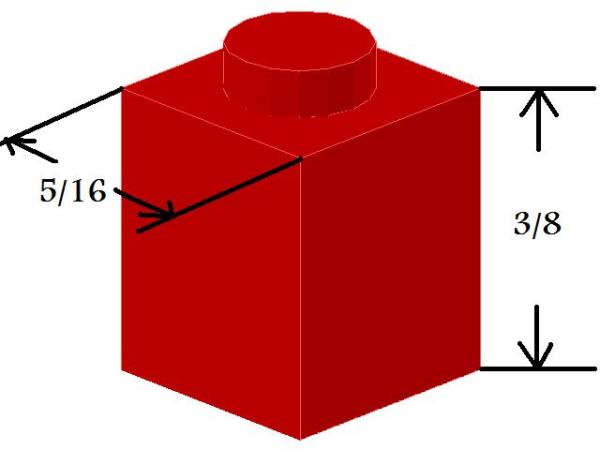Scale reference page.
This will be an ongoing study of scale in Mechaton, its implementation, its effect on our perceptions of our models, and its effect on game-play.
What is a mecha that is small enough to play Mechaton with in mini-fig scale? A hard suit. This is what the “Clasic” would look like in that scale.

The "Clasic" as a hard suit.

micro plus scale
The second pic is in a classic micro fig scale. At five plates high the soldier model is more of a location and height marker for the infantry unit, not an indication of width. At this scale the mech is now 18 feet tall, that is 6 yards or 5.49 meters tall.

micro scale
The third shot is at “Two plate scale.” This increases the height of our mech to 45 feet, 15 yards, or 13.72 meters tall. At this scale our “infantry marker” can represent a whole squad of soldiers.

Two plate scale
The fourth picture is at one “Tile” scale. Our mech becomes 90 feet, 30 yards or 27.43 meters tall. As you might have predicted our infantry “Tile” can represent an entire infantry platoon if we so choose.

Tile scale
You may have noticed that Lego measurements are not very “round” in the metric system. This is because even though Lego is produced in a country that uses the metric system, on machines built to metric standards, the original dimensions of the basic Lego brick are in increments of an inch.

Armed with this knowledge it is possible to come up with scale measurements for any Lego model you may build, in whatever scale you chose to play in.
As we all know the basic 1×1 is not a cube, therefore it “stacks” to a different height on its side than it does when the studs are upright. I personally refer too these two types of measurement as “stud height,” and “block height.”
These two measurements types are both useful, but do come up with different measurements for the same model. This can be corrected by converting your measurement to a scale equivalent.
As different as these two types of measurement are they do converge periodically. It is another indication of Vincent’s intrinsic brilliance that he created the classic to exist at the first convergence.


The “Classic” is exactly six “studs” high, and five “blocks high.
In “Micro-fig Plus” scale our six foot tall soldier is seven plates high, so our measurements are:
Plate = 10.28 inches
Stud = 25.7 inches
Block = 30.84 inches
In “Micro-fig” scale our six foot tall soldier is five plates high, so our measurements are:
Plate = 14.4 inches
Stud = 36 inches 0r 1 yard
Block = 43.2 inches
In “Two Plate” scale our six foot tall soldier is two plates high, so our measurements are:
Plate = 3 feet
Stud = 7 feet and 5.5 inches
Block = 9 feet or 3 yards
In “Tile” scale our six foot tall soldier is one tile high, so our measurements are:
Plate = 6 feet
Stud = 15 feet
Block = 18 feet
Now go forth and measure your Mechaton MOC’s.
I think the three things that make the size of the mecha real for us are: the people, the vehicles, and the buildings. I already went over the “people,” so lets look at the other two, cars first.
We fixed the height of our “scale” soldier silhouette at six feet. Now we all know that people come in many different sizes, and the same is true for cars. A quick online search told me that the smart car is only 8.8 feet long, while the 1966 Chrysler Imperial was 19 feet long, so there is a little room to play with as far as the size of a “car” is concerned.
What we need is the average car, because with lego it is difficult to make minor adjustments at the sizes we are talking about. We need something like the Toyota Camry, a mid sized sedan that measures 5 feet and 11.7 inches wide, by 15 feet and 9.2 inches long.
Lets take a look at micro fig scale first. Our six foot tall soldier is five plates high, that means that a car two studs wide by four studs long, is six feet wide by twelve feet long. That is reasonably close to the dimensions of our “average sized” car.



Now lets look at “Two Plate” scale. At this scale a one stud by two stud car is 7.5 feet wide by 15 feet long. That is still pretty darn close to our “average size” car.

Remember our “infantry marker” represents three or four soldiers at this scale.

Moving on to “Micro Fig Plus” scale we have a little more room to manuver, but not by much. A car three studs wide by seven studs long is 6 feet and 5 inches wide by 15 feet long. Very close.









This was really helpful. Thanks!
Very useful information here, sir.
Great article.
A well laid out article.
However, for micro plus scale, it is easier to imagine a 7 plate person as being 5’10”. Its only 2 inches less, and 5’10’ equals 70 inches. So that’s 10 inches a plate, 30 inches a brick, and 25 inches a stud. Much easier whole numbers to remember 🙂